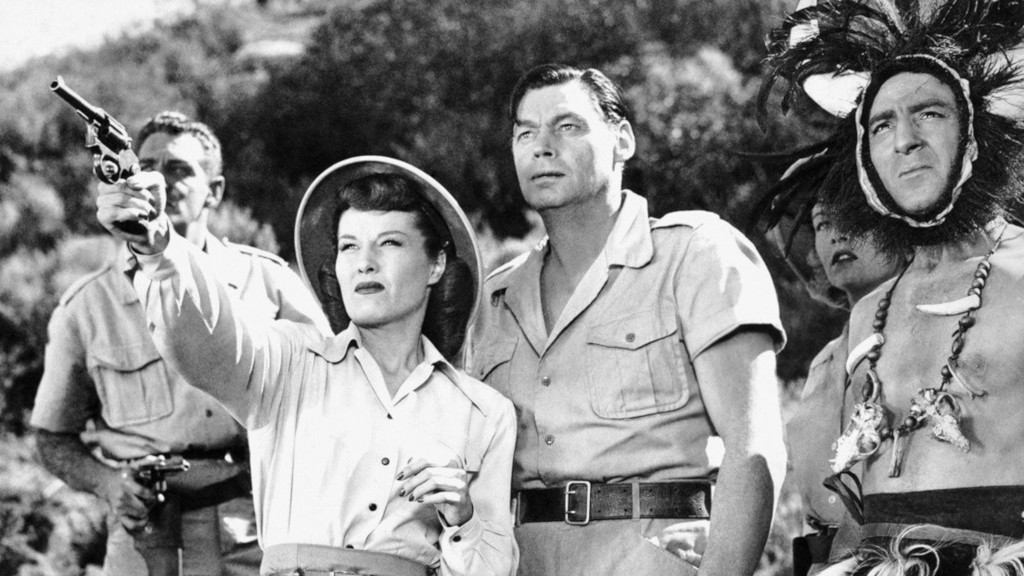
In the 8th Jungle Jim installation, Johnny Weissmuller tries his best not to hunt down a “missing link” species of giant ape-men, while battling a plush panther and stock footage. It’s a clunky, but entertaining and well-acted juvenile potboiler. 4/10
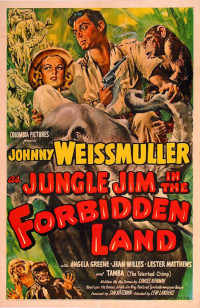
Jungle Jim in the Forbidden Land. 1952, USA. Directed by Lew Landers. Written by Samuel Newman. Based on comic strip by Alex Raymond. Starring: Johnny Weissmuller, Angela Greene, Jean Willes, Lester Matthews, William Tannen. Produced by Sam Katzman. IMDb: 6.2/10. Rotten Tomatoes: N/A. Metacritic: N/A.
Let’s get this over with immediately: the title of this 1952 movie is Jungle Jim in the Forbidden Land. The first part is correct: the film features Johnny Weissmuller as Jungle Jim. However, Jungle Jim never enters the Forbidden Land, nor is any Forbidden Land ever mentioned in the movie. One land that is mentioned, frequently, is the land of the giant people, but Jim doesn’t enter there either, but rather onto its doorstep, in the last ten minutes of the movie.
Yes, every time we get a title that completely misrepresents the film, we can be pretty sure that it’s a low-budget cheapo meant to fill out the bottom half of a movie bill and bring in enough juvenile audience to make a decent profit. In this case, it is the 8th entry into Columbia’s string of 16 Jungle Jim films made between 1948 and 1955, all starring Johnny Weissmuller of Tarzan fame. As usual, the plot is secondary, but at least it’s a pretty fun ride.

And by “secondary”, I do by no means mean “simple”. But I’ll try to describe it as briefly as possible. Try to keep up. A flood in the fictional Southeast-Asian country of Wasabi (yes, you read correct) has trapped the elephants on the wrong side of an impassable mountain range, and during their absence, the Wasabi population’s economy will suffer. But it is also bad news for poachers, who now can’t get to the ivory trapped on the other side. However, in caves under the mountains live a race of giants, and they guard a pass running through the mountain. If the elephants could be led through this pass, all problems would be solved. Problem is, nobody knows exactly where this land of the giants is, except the two giants that the government has captured, but they aren’t very talkative. And yes, of course, Jungle Jim.
This is the tactical setup. Add to this beautiful anthropologist Dr. Linda Roberts (Angela Greene) who tries to convince Jim to take her to the land of the giants so she can study the inhabitants, whom she believes to be a “missing link”, plus the two poachers, femme fatale Denise (Jean Willes) and her boyfriend “Doc” Edwards (William Tannen), as well as a local tribe led by the greedy mercenary Zulu (Frederic Berest). And then, of course, there’s the two “giants” (Clem Erickson and Irmgard Helen H. Raschke). And of course, Jim’s steady companion, the multi-talented chimp Tamba (Tamba).
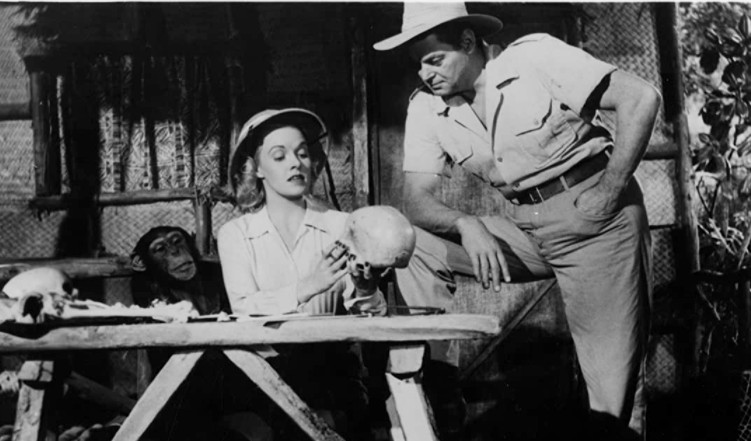
Now, Jungle Jim has no intention of leading anyone to the land of anything, as he thinks the dangerous giants are perfectly happy to be left alone in their cave, and would prefer they stayed there, undisturbed. But when the sneaky poachers come up with the idea of letting the captured giants go free, so that they can lead them to their home, Jim springs into action. Well, not so much springs, as lurches right into a trap where he is knocked unconscious and framed for murder. Can he rely on Dr. Linda and Tamba to save him from the pickle? And can they catch up with Doc and Denise before they kill all the elephants and let loose the giants into the jungle? Well, knowing Johnny Weissmuller, this will all be cleared up with some good luck and a fisticuff, and probably with some help from the local wildlife.
Jungle Jim, while perhaps not particularly well remembered today, was a hugely popular franchise from the mid-thirties to the early fifties. The character was created by legendary comic illustrator Alex Raymond at the same time as he created his best known hero, Flash Gordon, in 1934. Working for King Features Syndicate, Raymond and writer Don Moore conjured up Jungle Jim as a “topper” to go above Flash Gordon in the syndicate’s Sunday papers. Unlike Flash Gordon, Jungle Jim never ran as a daily, but was popular enough to run for 20 years in the syndicate’s Sunday issues, and crossed over to comic books, paperbacks, radio, film and TV.
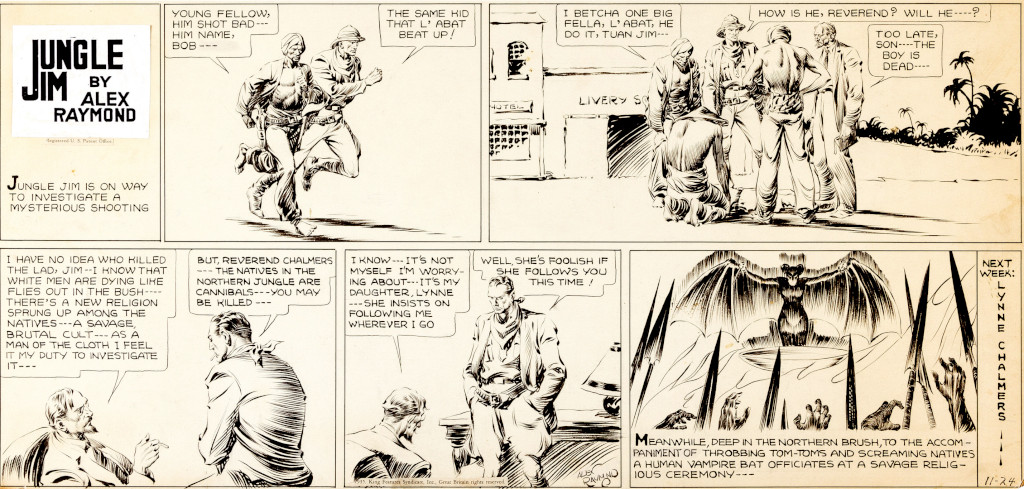
The most obvious inspiration for Jungle Jim was Edgar Rice Burroughs’ character Tarzan, originally created in 1912 as a newspaper serial, and first published as a novel in 1914. The origins of Tarzan can be traced back to Rudyard Kipling’s Mowgli (1893) and probably Albert’s Robida’s Saturnin Farandoul (1879), but it was Tarzan that ultimately launched something of a cottage industry of noble jungle heroes, including Ka-Zar, Ki-Gor and Bomba, the Jungle Boy. However, for Jungle Jim, Raymond and Moore sidestepped the “feral boy” trope as outlined by Mowgli, Tarzan and Tanar of Pellucidar, another Burroughs creation. Instead Jungle Jim is an American a hunter and tracker based in Southeastern Asia, rather than the popular choice of Africa.
Otherwise, Jungle Jim shared many characteristics with Tarzan and other juvenile heroes of the era, as an intelligent, morally upright and chivalrous man of action relying on his wits, strength and his natural superiority as a white Anglo-Saxon in a country of “savages” to fight injustice, hunt poachers and save damsels in distress from both kidnappers and more outlandish enemies. The similarities were no coincidence, as Jungle Jim was created as a rival to United Feature Syndicate’s comic strip adaptation of Tarzan.
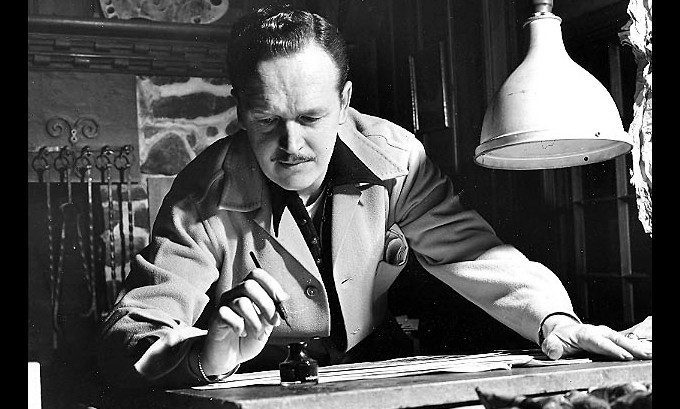
The stories were quickly picked up by the radio in 1935, and by the time them show finished, over 800 Jungle Jim episodes had aired. In 1937 Jim Bradley (as his full name rings out) took his first step onto the silver screen in Universal’s 12-episode film serial, starring Grant Withers, and a number of other publishing houses ran either reprints or published new comic books with the adventures of Jungle Jim in the late forties and early fifties. And by 1948 Columbia Pictures produced the first of what would eventually become 16 feature films (1948-1955) and a TV series (1955-1956), all starring Johnny Weissmuller as the title character. (Although, because of legal reasons, the last three films weren’t “officially” Jungle Jim films, because the TV series, which was being produced at the same time, was made by Columbia’s daughter company Screen Gems, who now held the rights to the name Jungle Jim. In the last three films Weissmuller’s character is called Johnny Weissmuller, although he is otherwise indistinguishable from Jungle Jim.) Jungle Jim in the Forbidden Land is the 8th of Columbia’s movies, and stands on this blog as an example of a one of a couple of pictures in the franchise that sort of touch upon SF — one other being the somewhat odd Fury of the Congo (1950), in which Weissmuller protects a zebra-antelope hybrid species from evil men who want to exploit her glands.

Whether Jungle Jim in the Forbidden Land is based on one of the comic strip stories, the radio show or is all new material, I haven’t been able to find out, but it’s probably a little bit of all three. The film version of Jungle Jim, anyway, was tailored to suit Johnny Weissmuller. More or less all 16 movies found an excuse for the former Olympic medalist swimmer to dress down to his undies and take a dip into a nearby lake or river, and the film even added a Cheetah Ersatz in Tamba the chimp. Jungle Jim even took on Tarzan’s brusque manners and short, clipped, sometimes even grammatically incorrect manner of speaking, even though there’s no discernible reason as to why Jim Bradley wouldn’t speak proper English.
Jungle Jim in the Forbidden Land ranks among the lesser half of the Jungle Jim movies, based on their IMDb ratings, not that the difference between the lesser and the better halves is tremendous. It was directed by Lew Landers, one of the many prolific, professional and steady-handed B-movie directors of Hollywood’s Golden Age and beyond. Landers doesn’t have on his list any of those hilariously bad genre films that you laugh your way through, nor really any films that have put his names in the history books for their vision or quality. He is best known for directing Bela Lugosi and Boris Karloff in the 1935 horror thriller The Raven. I haven’t found any figures on the budget of these movies, but they couldn’t have been high, and Landers does what he can with he meagre resources, greatly helped by stock footage provided by producer Sam Katzman and by editor Henry Batista. The jungle sets are passable and the filmmakers even get their hands on an elephant, allowing for a short scene where Dr. Linda twists her ankle and is in need of a “taxi”. The action is relatively well handled, with a few somewhat laughable scenes — as the one where Weissmuller wrestles a plush toy panther for a minute or so. A reasonably well-crafted hippo prop is used to maximum effect, as Katzman has insisted on not one, but two hippo attacks in the film. The stock footage is also reasonably well incorporated into the movie, and hats should be doffed to editor Batista.
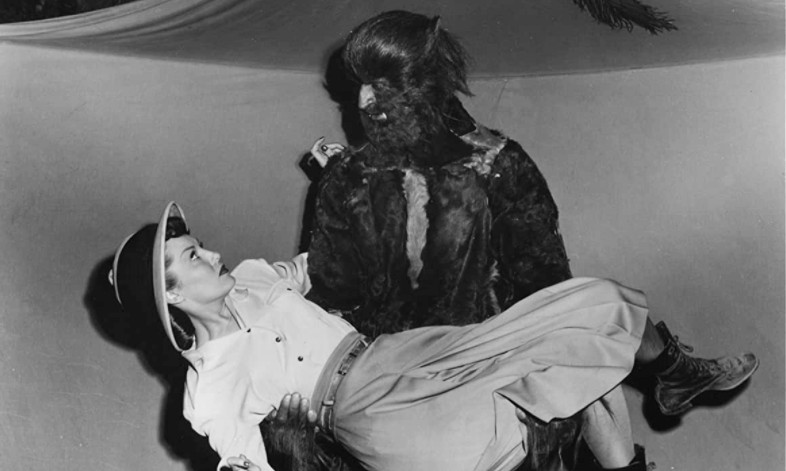
The “giants” in the film are disappointingly non-giant, but are rather tall actors in fur suits. Granted, Clem Erickson, playing the male giant, has the disadvantage of going up against 6’3 feet (191 cm) tall Johnny Weissmuller, but still manages to at least look a head taller than him in the shots. The suits are rather poor, although I have seen much worse. I’m not sure if the fur pants and coats they are wearing are supposed to look like the giants’ own fur, and in that case they are terrible. The face makeup looks like the ape makeup of Paula the Ape Woman in Captive Wild Woman (1943, review) and Ape Man in Bela Lugosi’s film with the same name (1943, review). For a more menacing effect, the giants have been dubbed with big cat growls. Clem Erickson and actress Irmgard Helen H. Raschke have no other recorded movie credits.

Johnny Weissmuller, the former Dutch five-time Olympic champion swimmer, by now a naturalised American, was never a thespian. But his physique, handsome face and charisma made him the most famous movie Tarzan of all time. Tarzan the Ape Man came out in 1931, and the time Tarzan and the Mermaids was released in 1948, the then 44-year-old Weissmuller didn’t quite fit the image of the legendary king of the jungle anymore. Not that the actor was in bad shape, but he was a bit long in the tooth, and to be honest, was becoming a just a wee bit flabby — and that loincloth isn’t forgiving. After 16 years and 12 films as Tarzan, he was able to prolong his career as jungle hero with another eight years, 16 films and a TV series thanks to Jungle Jim — a character that has been derided as simply “Tarzan in clothes”. Discounting a couple of shorts and a few cameos, Weissmuller played only three roles during his profitable 25-year-long movie career: Tarzan, Jungle Jim and Johnny Weissmuller. Weissmuller’s lack of acting chops is sadly on display in Jungle Jim in the Forbidden Land. He knows how to hit his mark and is good in any scenes that involve action. Weissmuller’s dry humour and natural charm also play very much in his favour, but there’s good reason why Jungle Jim is a man of just as few words as Tarzan was in his films.

Otherwise, the acting is fine in Jungle Jim in the Forbidden Land. Angela Greene (star of Night of the Blood Beast, 1958) is good as the headstrong, but prone to fainting leading lady, even if she gets a lot more acting support from Tamba than from Weissmuller. Jean Willes is a cut-and-paste femme fatale and William Tannen does what little he has to do as supporting villain with grace. Lester Matthews as the local commissioner, whom I’ve recently covered in my review of The Son of Dr. Jekyll (1951, review) is good as always.
Of course the portrayal of the fictive natives is highly problematic, as all non-whites in the film seem to run around with feathers on their heads sporting knives and loincloths, and are either portrayed as government soldiers or as devious mercenaries. That is, with the exception of “The Old One” (William Fawcett), a sort of ancient authority of Jim’s jungle. Still, the movie avoids the most egregious racism as seen in many similar movies, and at least Jim is portrayed as something of a respectful protector or the natives’ traditional way of life. On the other hand, he has no problem with the all-white colonialist government, and happily returns two tusks of ivory to a team of ivory traders after they have been stolen by Zulu and his men. Profiting off the indigenous people and their the wildlife apparently isn’t a problem as long as it is done within government regulations.

The reason why this movie appears on this blog is, of course, the “giant people”. Not that giants are inherently of SF nature, but in this case the giants are given a scientific explanation, as they are suspected to be a lost race of “missing link” species between man and ape — a hot topic in the fifties, a decade which would very soon be flooded with movies about yetis and Neanderthal men. Unfortunately, the giants are not much more than MacGuffins in the movie, as well as a means to give Weissmuller yet another formidable foe to wrestle with (hippos, panthers, a tribe of natives and a squadron of soldiers apparently not being enough). They are not given any personalities, nor do they really have a story, other than conveniently appearing out of the blue when the plot calls for them to do so.
The “missing link” or “ape man” trope goes back at least to the publication of Charles Darwin’s The Origins of Species, and was popularised in fiction by stories such as Arthur Conan Doyle’s The Lost World (1912) and Edgar Rice Burrough’s The Land That Time Forgot (1918). Missing link-like creatures like ape men and ape women, often artificially created, started popping up in Hollywood B-movies in the wake of big ape successes like the exploitation mockumentary Ingagi (1930) and King Kong (1932, review) in films such as Island of Lost Souls (1932, review), Dr. Renault’s Secret (1942, review), Captive Wild Woman, The Ape Man and Return of the Ape Man (1944, review). And of course, there were numerous movies with “intelligent” big apes, more often than not showing a peculiar interest in the leading ladies of these pictures. Many jungle films contained some ape/man hybrid, but few elaborated further. At least Jungle Jim in the Forbidden Land takes some effort to put the “giants” into some sort of scientific context. However, this is a juvenile jungle potboiler, and apart from Dr. Linda measuring a skull at one point, there really is no science in the film.
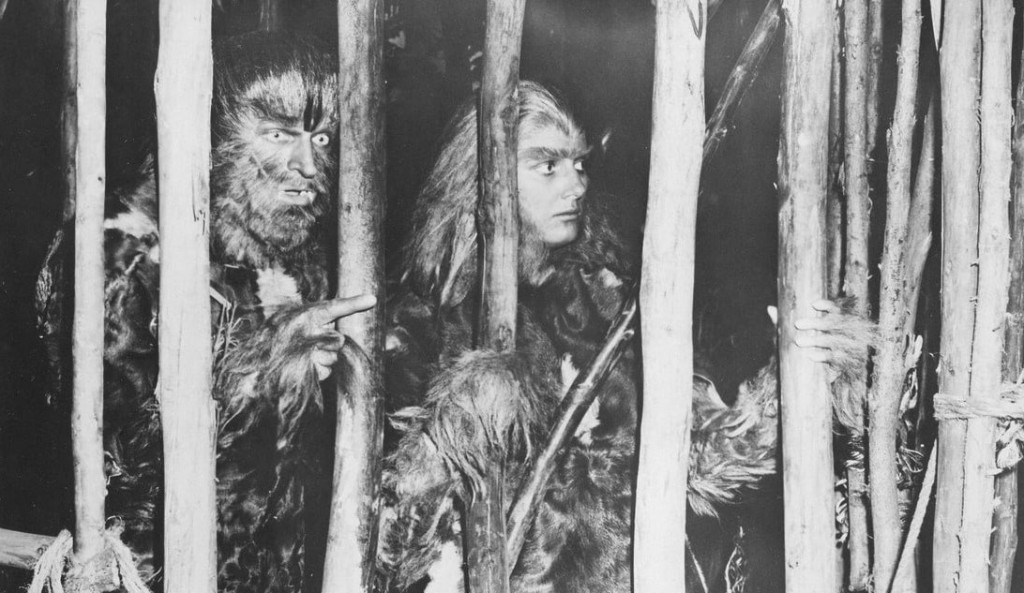
Modern critics seem to hold these old Jungle Jim films in some affection, despite their poor scripting and production values. At-A-Glance Film Reviews gives Jungle Jim in the Forbidden Land 2.5/5 stars, writing: ” It’s a pretty poorly made, poorly thought out movie […] but the camp value is cranked so high that it’s kind of fun anyhow”. Dave Sindelar at Fantastic Movie Musings calls it “fairly entertaining in a low-budget ‘Jungle Jim’ kind of way”. Both TV Guide and Derek Winnert give it 2/5 stars, without elaborating past the obvious. Mark David Welsh is perhaps not sold on the film: “The Jungle Jim features were cheap, conveyor belt fodder aimed squarely for the bottom half of the bill on the out of town theatre circuit. But this is quite definitely a candidate for the feeblest one in the entire series.”
I thoroughly enjoyed the film, despite its many flaws. At 65 minutes, it’s breezy and punctuated by action scenes every ten minutes. The acting by everyone but Weissmuller is good enough to carry the film, and as said, the direction and editing is professional, with a couple of almost impressive editing sequences. The script is and plot is secondary, and mostly seems to be cobbled together to get Jungle Jim from one action sequence to the next. It’s too bad screenwriter Samuel Newman isn’t able to do anything with the giant people, other than having them around as catalysts for action sequences. One also feels a bit short-changed as the characters keep talking about the land of the giant people all through the movie, and when we finally get there, we just stop by the entrance and for a shootout without ever seeing any more of the giant people than the two we have seen through the rest of the film. Of course, this was a budgetary decision, but still it’s kind of a gaffe.

Screenwriter Samuel Newman wrote two of the more bizarre SF movies of the late fifties. He was co-writer on the legendary turkey The Giant Claw (1957, review), memorable for its hilarious titular monster — a giant, crazed bird, something of a mix between a turkey and a vulture, which looks as if it has been through a car wash. In all actuality, the script for the movie isn’t terrible. It’s just that when the bird appears, it’s impossible to take the movie seriously. The second is Invisible Invaders (1959), a film starring John Agar and John Carradine, in which aliens attack by inhabiting the bodies of the recently deceased. In other words: alien zombies.
Irish model-cum-actress Angela Greene had longer and more prolific career than many of the beauty pageants that were chewed up ans spit out by Hollywood, or decided/were forced to give up the business when they got married and had children. Unfortunately, that career was cut short in 1978, when she died of a stroke at only 57 years old. Apart from Jungle Jim in the Forbidden Land, Greene played the female lead in two other science fiction movies, most notably the infamous Roger Corman production Night of the Blood Beast (1958), but also the John Carradine vehicle The Cosmic Man (1959). In 1976 she had a substantial supporting role as Mrs. Reed, one of the ill-fated guests at Futureworld, the sequel to the classic Westworld (1973).
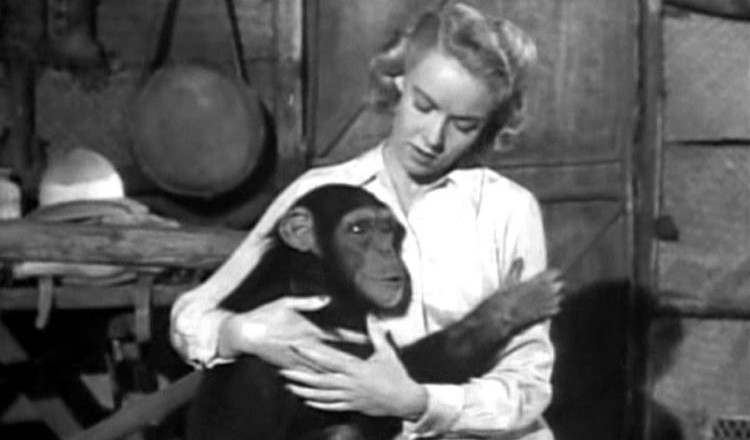
The femme fatale of the film was Jean Willes, with over 200 film or TV credits to her name between 1942 and 1976. Her career was somewhat similar to Angela Greene’s: She would play leads in B-movies, but get relegated to bit parts in the A-films she appeared in. But while Greene was often the ingenue, the curvy, expressive Willes got meatier roles as gun molls, prostitutes, femme fatales, gold-diggers and saloon girls. And like Greene, she became a staple TV guest star on a whole range of respectable shows from the early fifties onward. She is probably best known for her large supporting role as Nurse Sally Winters in Don Siegel’s SF classic Invasion of the Body Snatchers (1956, review), but also appeared as “Venutian Captain Olivia” in Abbott and Costello Go to Mars (1953), and had a sizable part in another Sam Katzman SF, The Man Who Turned to Stone (1957, review).

William Tannen, playing the sidekick villain, was an extremely prolific bit-part and supporting actor, with over 300 films or TV series to his name. Often seen in westerns, he is probably best known for playing Deputy Hal Norton in the TV show The Life and Legend of Wyatt Earp between 1956 and 1958. He had a small role in the 1941 Spencer Tracy version of Dr. Jekyll and Mr. Hyde (review), and a bit part in Panic in the City (1968).
Frederic Berest, who plays the devious Zulu, was usually cast (in his two dozen films) as thugs, “necromancers”, cossack captains, native chiefs or other unsavoury characters. Somewhat surprising then, he was cast as John the Baptist in the 1952 TV series The Living Bible.
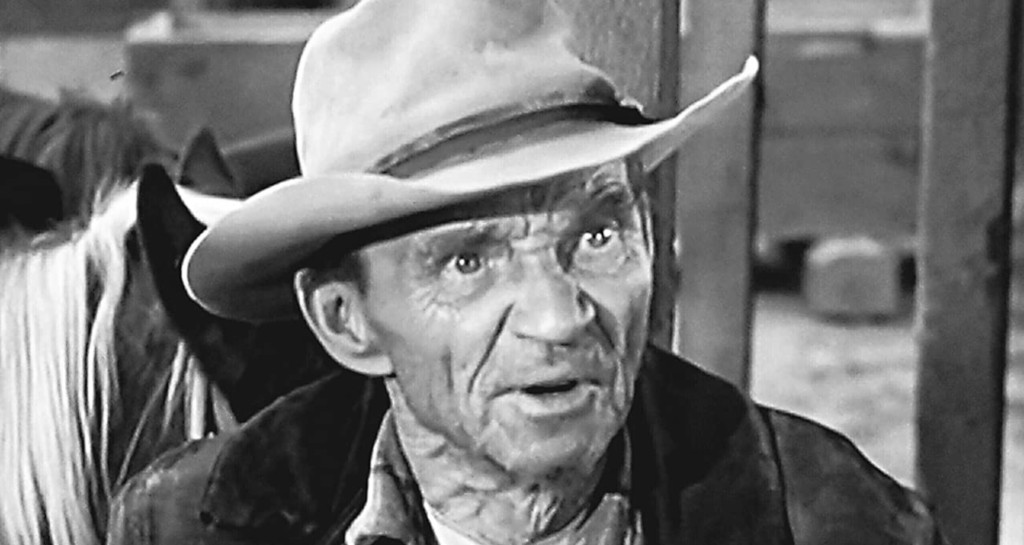
William Fawcett plays the old, lined “Old One”, the revered jungle elder, in Jungle Jim in the Forbidden Land. Far from a marquee name, Fawcett became a staple in western movies playing every imaginable “old coot” after WWII. He is especially well remembered by people who grew up with fifties TV as the “irascible ranch foreman Pete Wilkey” on the show Fury (1955-1960). Many of is most memorable roles, however, were outside of westerns. He had a recurring role as the wheelchair-bound Prof. Hammill in the film serial Batman (1949, review), and played Merlin opposite future Superman George Reeves in The Adventures of Sir Galahad (1949). In 1952 he appeared as the high priest opposite former Tarzan, Flash Gordon and Buck Rogers, Buster Crabbe, in the jungle adventure King of the Congo. Few viewers probably suspected that this “old coot” was not only an anointed priest, but also a former professor in theatre arts at the University of Michigan. Having been bitten by the theatre bug in church dramas, after serving in WWI, he elected to leave the papal robe behind and take up acting in earnest. After working at repertoire and stock companies in his twenties and thirties, he took up theatre studies, and earned a Ph.D., whereafter he was offered a position as Professor. However, efter returning from service in yet another world war, he decided he wanted to get back to acting, and this time headed for Hollywood. And Hollywood didn’t disappoint. Fawcett appeared in over 300 films or TV shows between 1946 and 1972. Kudos to the always reliable Western Clippings for providing a biography on Fawcett.
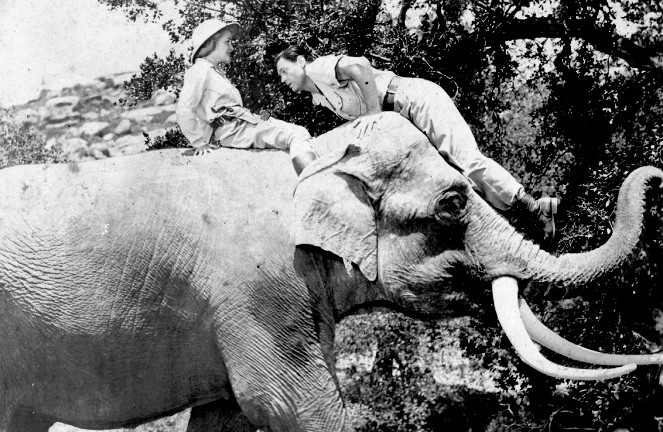
John Hart, who has a small role as the commissioner’s secretary seemed destined for fame when he entered Hollywood in the late thirties, from having been appearing on stage. With acting chops, a killer physique and the face of a leading man, he seemed destined for big things. But WWII stopped him in his tracks, and when he returned from service, he was back at square one, and never quite made the big lights. However, he is famous enough to have a star on the Hollywood Walk of Fame, partly thanks to his one-year stint as the beloved hero The Lone Ranger in the TV series with the same name, in 1952 and 1953, replacing the regular masked western vigilante Clayton Moore in 54 episodes. Hart has said: “I’ve been the “other” Lone Ranger for 50 years. There are worse things people could call me.” His other claim to fame is playing Hawkeye in the 1957 TV show Hawkeye and the Last of the Mohicans — opposite Lon Chaney, Jr. as said Mohican, a somewhat bizarre casting choice.
Hart was no stranger to SF, having appeared in the film serials Brick Bradford (1947), Batman and Robin and Atom Man vs. Superman (1950), as well as in the Jungle Jim picture Fury of the Congo. He had bit-parts in the George Pal movie Atlantis: The Lost Continent (1961) and The Astral Factor (1978). But his real claim to genre fame is being first-billed in the blacksploitation horror cult movie Blackenstein as the evil Dr. Stein, who creates a monster out of a black Vietnam war veteran who has lost all his limbs when stepping on a landmine. Interested in TV production, Hart soon took on (often uncredited) work behind the camera, with various tasks. For example, he worked as associate producer on two seasons of Quincy, M.E. in the early eighties, and did his last role in front of the camera in 1982. After this, he worked mainly as a dubbing supervisor on a number of highly successful TV shows, including Transformers (1984-1987) and G.I. Joe (1985-1986).
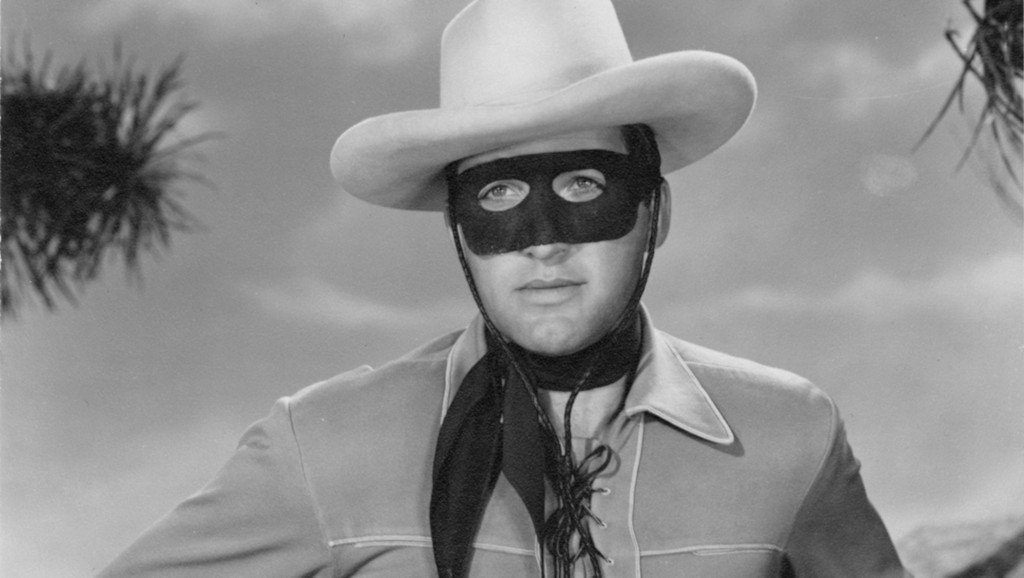
Stuntman Paul Stader had worked as Johnny Weissmuller’s stunt double on a number of Tarzan films and Jungle Jim movies. His SF resumé is quite impressive, and not only as a stuntman, but also assistant director and even producer. He worked as a stuntman on such films as Voyage to the Bottom of the Sea (1961), The Andromeda Strain (1971) and Eve of Destruction (1991). He was stunt coordinator on Beneath the Planet of the Apes (1970), Conquest of the Planet of the Apes (1972) and Battle for the Planet of the Apes (1973). An avid swimmer and diver (he doubled for a 5-time Olympic champion, remember?), he eventually graduated to directing, especially as assistant director on scenes that required stunt work and action in and under water. Among the films on which he worked as assistant or second unit directors are The Monster that Challenged the World (1957, review), Dinosaurus! (1960), The Neptune Factor (1973) and Alligator (1980). And he even worked as producer on the low-budget screamer It’s Alive III: Island of the Alive (1987).

The makeup was designed by Clay Campbell, whom we’ve recently covered in our review of The Son of Dr. Jekyll (review). Campbell had previously made up Boris Karloff for the Columbia SF horrors The Man They Could Not Hang (1939, review) and Before I Hang (1940, review). He also worked on KIller Ape (1953) , The Werewolf (1956, review) and The 30 Foot Bride of Candy Rock (1959). Campbell was noticed by Perc Westmore, the head of Warner’s makeup department, when he was commissioned to make wax puppets for The Mystery of the Wax Museum (1933), and was hired, but eventually ended up at Columbia, where he became their head of makeup. Campbell is responsible for the werewolf makeup that debuted in Return of the Vampire (1943), popped up in the Three Stooges short Idle Roomers (1944) and was later perfected for The Werewolf. In my opinion, it trumps the iconic Lon Chaney-look from Universal’s Wolf Man films, which I have never been particularly fond of.
Janne Wass
Jungle Jim in the Forbidden Land. 1952, USA. Directed by Lew Landers. Written by Samuel Newman. Based on the comic strip Jungle Jim by Alex Raymond and Don Moore. Starring: Johnny Weissmuller, Angela Greene, Jean Willes, Lester Matthews, William Tannen, George Eldredge, Frederic Berest, Clem Erickson, Irmgard Helen H. Raschke, William Fawcett, John Hart. Cinematography: Fayte Browne. Editing: Henry Batista. Art direction: Paul Palmentola. Makeup artist: Clay Campbell. Sound: J.S. Westmoreland. Johnny Weissmuller’s stunt double: Paul Stader. Produced by Sam Katzman for Sam Katzman Productions and Columbia Pictures.

Leave a comment